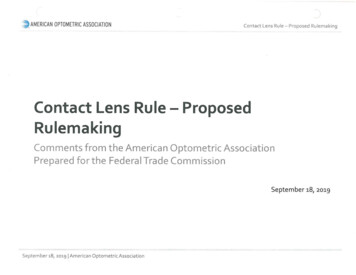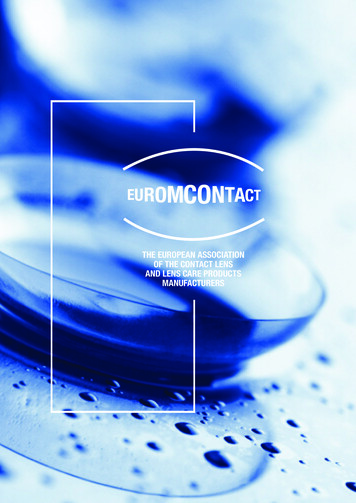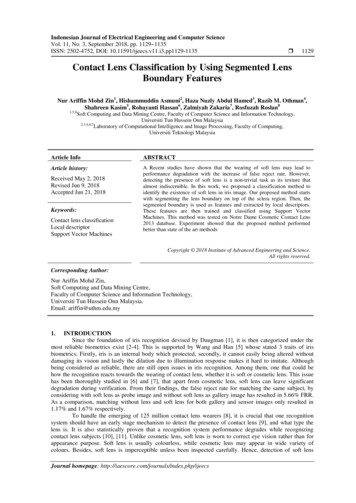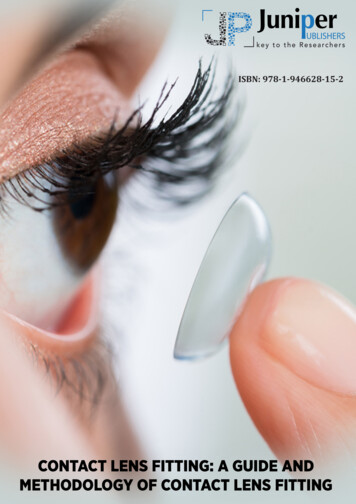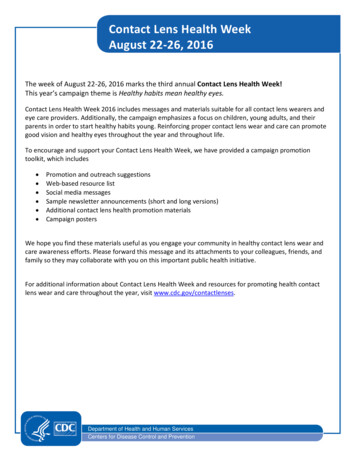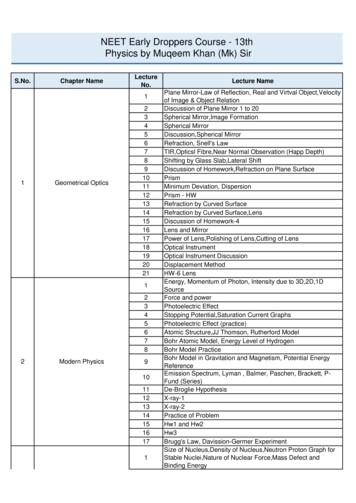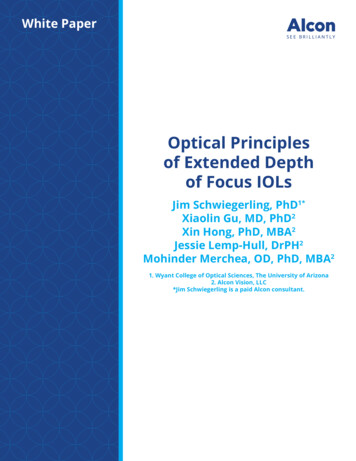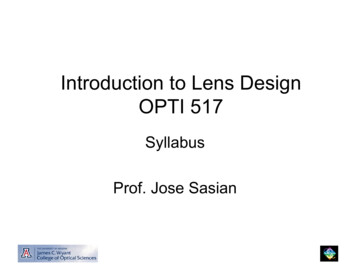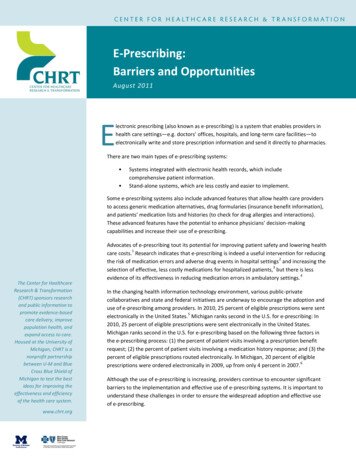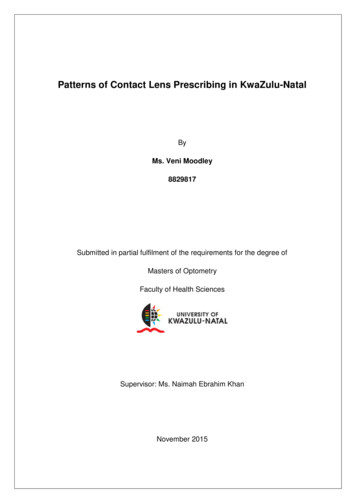
Transcription
Patterns of Contact Lens Prescribing in KwaZulu-NatalByMs. Veni Moodley8829817Submitted in partial fulfilment of the requirements for the degree ofMasters of OptometryFaculty of Health SciencesSupervisor: Ms. Naimah Ebrahim KhanNovember 2015
DECLARATIONSTUDENTS DECLARATIONI, Veni Moodley, hereby declare that the dissertation submitted for the degreeMaster in Optometry to the University of KwaZulu-Natal has not been submittedbefore for consideration for a degree at this University or any other Universitypreviously.MS VENI MOODLEYSUPERVISORS DECLARATIONI hereby declare that the preparation of this project was supervised in accordancewith the guidelines of research supervision laid down by the University ofKwaZulu-Natal.MS NAIMAH EBRAHIM KHANi
DEDICATIONThis dissertation is dedicated to my daughter Avani for her patience andproviding me with the inspiration to undertake this academic endeavouralongside her own.ii
ACKNOWLEDGEMENTSThe writing of this dissertation has been a significant academic challenge. I owemy deepest gratitude to the following people: My husband, Nash, for his constant love and encouragement and myappreciation is infinite. My supervisor, Ms Naimah Ebrahim Khan, for her commitment, academicguidance and constant supervision in ensuring that my milestones weremet. The participants in the survey for their enthusiastic involvement in myresearch. The numerous people in various study groups and individual meetingswhom I encountered over the course of this study.iii
ABSTRACTIntroduction: The prescribing of contact lenses to correct common refractiveerrors is a growing trend in the optical industry. This can be attributed to the ongoing research and development in contact lens designs and material. Thisresearch will provide information to assist the contact lens practitioner keepabreast of prescribing trends in KwaZulu-Natal.Aim: To determine the contact lens prescribing trends in KwaZulu-Natal for thecorrection of common refractive errors.Method: A quantitative research method was employed in this study.A self-administered questionnaire was used. Probability sampling technique was used forthe two stage sampling procedure.Random sampling strategy was used todetermine the primary population (n 40) which included all optometrists,registered with the Health Professions Council of South Africa (HPCSA). A clustersampling strategy was used to select the secondary population (n 400) whichincluded all contact lens wearers in KwaZulu-Natal.The data collected wasprocessed and analysed using the Statistical Package of Social Sciences (SPSS).Results: The results were presented in two sections: Regarding the optometristprofile, the participants consisted of 35% male and 65% female of which 60% wereIndian, 25% were White, 7% were Coloured and 5% were African. The results ofthe survey indicated that 75% of contact lens practitioners prescribe onlydisposable contact lenses.Regarding the contact lens wearer, the genderdistribution was 68% females and 32% males and the age ranged from 7 years to91 years with a mean of 34.61 ( 13.72) years and mode of 30 years.Furthermore, the racial profile showed that Indians and Whites represented 41%and 43% of all contact lens wearers. The majority of contact lens wearers (72%)are existing wearers. Spherical lens design was mostly prescribed with siliconehydrogel being the preferred material.Furthermore, silicone hydrogel materialwas most common prescription for both the new fit and re-fitting of contact lenses(p 0.029). Monthly replacement contact lenses were most widely prescribed at82% with 96% of contact lenses worn on a daily wear modality.iv
Conclusion: The contact lens prescribing trends in KwaZulu-Natal for thecorrection of common refractive errors is comparative to international trends ofcontact lens prescribing.Key words: Contact lens, Contact lens wearer, prescribing trends, questionnaire,surveyv
LIST OF FIGURESFigure 2.1: A schematic representation of the upper eyelid and conjunctivaFigure 2.2: A schematic representation of the layers of the tear filmFigure 2.3: A schematic representation of the corneaFigure 4.1: Gender distribution of optometristsFigure 4.2: Racial profile of optometristsFigure 4.3: The highest level of education achievedFigure 4.4: The number of years of experienceFigure 4.5: The percentage of contact lens wearers that is non-compliant withcontact lens care instructionsFigure 4.6: Percentage of contact lens wearers that constitute a practiceFigure 4.7: Percentage of the contact lens practitioners that prescribe rigid gaspermeable contact lensesFigure 4.8: Reasons for not fitting rigid gas permeable contact lensesFigure 4.9: Percentage of disposable contact lenses fittedFigure 4.10: Percentage of conventional contact lenses prescribedFigure 4.11: Percentage of contact lens practitioners that prescribe scleral lensesFigure 4.12: Percentage of cosmetic contact lens wearers that make up thecontact lens patient baseFigure 4.13: Percentage of contact lens wearers fitted with toric contact lensesFigure 4.14: The age distribution of contact lens wearers in KwaZulu-NatalFigure 4.15: The racial profile of contact lens wearers in KwaZulu-Natalvi
Figure 4.16: The race of the contact lens wearer and the type of fitFigure 4.17: Refractive errors presented by contact lens wearersFigure 4.18: Contact lens material prescribedFigure 4.19: The type of fit and contact lens material prescribedFigure 2.20: Cosmetic contact lenses prescribedFigure 4.21: Percentage of contact lens fitting by the design of the contact lensFigure 4.22: Level of astigmatism in the right eye and the design of contact lensprescribedFigure 4.23: Level of astigmatism in the left eye and the design of contact lensprescribedFigure 4.24: Frequency of replacement of contact lensesFigure 4.25: Contact lens modality of wearFigure 4.26: Medical problems experienced by contact lens wearersFigure 4.27: Contact lens related complications associated with contact lens wearFigure 4.28: Dry eyes experienced and the type of material prescribedvii
LIST OF TABLESTable 4.1: Frequency table indicating the gender of the contact lens wearerTable 4.2: Type of contact lens fit (refit or new fit)Table 4.3: Cross-tabulation between the refractive error and the gender of thecontact lens wearerTable 4.4: Cross-tabulation between frequency of replacement and the gender ofthe contact lens wearerTable 4.5: Cross-tabulation between the modality of the contact lens wearingschedule and the gender of the contact lens wearerTable 4.6: Cross-tabulation between the different age categories and dry eyesExperiencedviii
LIST OF ACRONYMSCPD:Continuing professional developementHSSREC:Humanities and Social Sciences Research Ethics CommitteeHPCSA:Health Professions Council of South AfricaKZN:Kwa-Zulu NatalRGP:Rigid gas permeableSPSS:Statistical Package of Social Sciencesix
TABLE OF CONTENTSDeclaration . iDedication . iiAcknowledgements . iiiAbstract . ivList of Figures . viList of Tables . viiiList of Acronyms . ixChapter 1. Introduction . 11.1.INTRODUCTION . 11.2.BACKGROUND . 11.3.PROBLEM STATEMENT . 71.4.HYPOTHESIS/RESEARCH QUESTION. 71.5.AIM AND OBJECTIVES . 81.6.TYPE OF STUDY AND METHOD . 91.7.SIGNIFICANCE OF THE STUDY . 9Chapter 2. Literature review . 102.1. INTRODUCTION. 102.2. ANATOMY AND PHYSIOLOGY OF THE EYE . 102.2.1. The Eyelids . 102.2.2. Tear Film Physiology . 112.2.3. The Cornea . 122.2.4. The Limbus . 142.2.5. The Conjunctiva . 14x
2.3. REFRACTIVE ERROR . 152.3.1. Myopia . 152.3.1.1. Prevalence of Myopia . 162.3.2. Hyperopia . 162.3.2.1. Prevalence of Hyperopia .162.3.3. Astigmatism . 172.3.3.1. Prevalence of Astigmnatism .172.3.4. Presbyopia . 192.3.4.1. Prevalence of Presbyopia . 192.4. CONTACT LENSES . 202.4.1. History of Contact Lenses . 202.4.2. Benefits of Contact Lenses . 222.5. CLASSIFICATION OF CONTACT LENSES . 232.5.1. Contact Lens Material . 232.5.1.1. Rigid Gas Permeable Contact Lens . 242.5.1.2. Conventional Hydrogel Contact Lenses . 252.5.1.3. Silicone Hydrogel Contact Lenses . 262.5.1.4. Cosmetic Contact Lenses . 272.5.2. Contact Lens Design . 282.5.2.1. Bifocal Contact Lens . 292.5.2.2. Monovision Correction for Presbyopia . 302.5.2.2. Multifocal Contact Lenses . 302.5.2.3. Spherical Contact lenses . 282.5.2.4. Toric Contact Lenses . 322.5.3. Contact Lenses: Modality of Wear . 332.5.4. Contact Lenses: Frequency of Replacement . 342.6. SYSTEMIC DISEASES AND THE EYE . 34xi
2.6.1. Diabetes Mellitus. 342.6.1.1. Classification of Diabetes Mellitus . 352.6.1.2. Ocular Manifestations of Diabetes Mellitus . 352.6.1.3. Prevalence of Diabetes Mellitus. 362.6.1.4. Diabetes and Contact Lens Wear . 362.6.2. Asthma and Eczema . 372.6.2.1. Asthma . 372.6.2.2. Eczema . 372.6.2.3. Ocular Manifestations of Asthma and Eczema . 382.6.2.4. Prevalence of Asthma and Eczema . 382.6.2.5. Asthma, Eczema and Contact Lens Wear . 382.6.3. Rheumatoid Arthritis . 392.6.3.1. Ocular Manifestations of Rheumatoid Arthritis . 392.6.3.2. Prevalence of Rheumatoid Arthritis . 402.6.3.3. Rheumatoid Arthritis and Contact Lens Wear . 402.6.4. Thyroid Disease . 402.6.4.1. Ocular Manifestations of Thyroid Disease . 412.6.4.2. Prevalence of Thyroid Disease . 422.6.4.3. Thyroid Disease and Contact Lens Wear . 432.7. CONTACT LENS COMPLICATIONS . 432.7.1. Blepharitis . 442.7.1.1. Prevalence of Blepharitis . 452.7.1.2. Management of Blepharitis . 452.7.2. Dry Eye Syndrome . 462.7.2.1. Hyposecretive Dry Eye Syndrome . 462.7.2.2. Evaporative Dry Eye Syndrome . 472.7.2.3. Prevalence of Dry Eye Syndrome . 47xii
2.7.2.4. Management of Dry Eye Syndrome . 482.7.3. Hyperaemia . 492.7.3.1. Prevalence of Hyperaemia . 492.7.3.2. Management of Hyperaemia. 492.7.4. Hypoxia . 502.7.4.1. Prevalence of Hypoxia . 502.7.4.2. Management of Hypoxia . 512.7.5. Neovascularisation. 512.7.5.1. Prevalence of Neovascularisation. 522.7.5.2. Management of Neovascularisation . 52Chapter 3. Methodology. 543.1. INTRODUCTION. 543.2. RESEARCH DESIGN . 543.3. STUDY POPULATION . 543.4. STUDY SAMPLE AND SIZE . 553.5.INCLUSION AND EXCLUSION CRITERIA . 563.5.1. Contact Lens Practitioners . 543.5.2. Contact Lens Wearers 543.6. DATA COLLECTION INSTRUMENT . 573.7. DATA COLLECTION PROCESS . 583.8. DATA MANAGEMENT . 593.9. DATA ANALYSIS . 593.10. ETHICAL CONSIDERATIONS . 60xiii
CHAPTER 4. Results . 624.1. INTRODUCTION. 624.2. SECTION 1: OPTOMETRIST PROFILE . 624.2.1. Demographic Details. 624.2.2. Contact Lens Practice Trends . 644.3. SECTION 2: CONTACT LENS WEARER PROFILE. 694.3.1. Demographic details of contact lens wearers . 704.3.2. Contact Lenses . 734.3.3. Contact Lens Complications . 78Chapter 5. Discussion . 825.1. INTRODUCTION. 825.2. SECTION 1: OPTOMETRIST PROFILE . 825.2.1. Sample Size . 825.2.1. Demographic Details. 835.2.2. Contact Lens Practice Trends . 845.3. SECTION 2: CONTACT LENS WEARER PROFILE. 885.3.1. Demographic details of contact lens wearers . 885.3.2. Contact Lenses . 905.3.2.1. Contact lens material . 905.3.2.2. Contact lens design . 922.3.2.3. Contact Lenses: Frequency of replacement . 935.5.2.4. Contact lenses: Modality of wear . 945.3.3. Contact Lens Complications . 955.3.4. Management of Contact Lens Complications . 96xiv
Chapter 6. Conclusion . 986.1. INTRODUCTION. 986.2. SUMMARY OF FINDINGS . 986.3. LIMITATIONS OF THE STUDY . 996.4. RECOMMENDATIONS . 1006.5. CONCLUSION . 100REFERENCES . 101APPENDICES . 119Appendix I: QuestionnaireAppendix II: Letter from Director, Eurolens ResearchAppendix III: Ethics Approval NotificationAppendix IV: Information Document and Invitation to Participate (Gatekeeper)Appendix V: Information Document and Invitation to Participate (Contact lenspractitioner)Appendix VI: Consent to participate in research (contact lens wearer)Appendix VII: Health Professions Council of South Africa (Statistics and Analysis)xv
CHAPTER 1. INTRODUCTION1.1.INTRODUCTIONThe study describes the patterns of contact lens prescribing in KwaZulu-Natal,South Africa. This chapter outlines the background information as well as themotivation for the study. Furthermore, the problem statement, research questionas well as the aims and objectives of this study are presented. The significanceand the type of study and study method will be discussed.This chapter willconclude with an outline of the study.1.2.BACKGROUNDRefractive errors such as myopia, hyperopia, astigmatism and presbyopia affectvisual acuity. The use of contact lenses for the correction of these errors hasincreased tremendously over the years (Morgan et al, 2013).This markedincrease in contact lens use can be attributed to the continuous development ofthe contact lens material, designs, wearing modalities and replacement schedules(Kading and Brujic, 2013). The wide range of contact lenses available influencesthe prescribing trends of contact lenses. In addition to the correction of commonrefractive errors the use of contact lenses for cosmetic purposes as well as atherapeutic modality for corneal pathologies has given a multi-dimensional aspectto this optometric tool.Contact lenses can be used as an alternative to spectacle prescription and alsooffers many advantages. Despite the advances in spectacle lens technology, theuse of contact lenses as a form of vision correction is increasing around the world(Nichols, 2013). Pseudovs et al (2006) demonstrated with the aid of the Quality ofLife Impact of Refractive Correction (QIRC) questionnaire for comparing thequality of life of pre-presbyopic individuals with refractive surgery, contact lensesor spectacles. The study revealed that the QIRC score for contact lens wearerswas significantly better than for the spectacle wearers.1Furthermore, contact
lenses allow an unrestricted field of vision and the distortions which occur throughthe periphery of the spectacle lens are eliminated (Bhattacharyya, 2009). Contactlenses may also offer better visual acuity in keratoconic patients. Kastl et al (1987)reported that contact lenses were successfully fitted in 95% of patients withkeratoconus. In addition, results indicated that contact lenses should be the initialtreatment of choice for keratoconus.Estimates of the size of the contact lens population worldwide range from 125million in 2004 to 140 million in 2010 (Swanson, 2012). There were approximately38 million contact lenses wearers in the United States in 2012 (Nichols, 2012).Also, Asian countries such as China, Malaysia, South Korea Taiwan, Hong Kongand Singapore showed a growth of 7.4%, while the United States and Europeshowed a growth of 4.8% and 3.2%, respectively (Nichols, 2012). This report wasbased on the contact lens sales in 2011 as compared to the contact lens sales in2010. In South Africa, contact lens wear is gaining popularity; however there islimited research to compare South African contact lens trends to internationaltrends.Reviews of contact lens prescribing in twenty seven countries such as Australia,Canada, United Kingdom, United States of America, Germany and Norway havebeen conducted annually to understand the patterns of contact lens prescribingand factors that influence this trend (Morgan et al., 2001-2014). This study willaim to fill the information void in this regard.The PEAR Study by Oduntan et al (2007) revealed that 26.6% of optometrystudents completing their undergraduate studies in 2006 at the four universities inSouth Africa were least prepared in the field of contact lenses, while only 28% ofstudents felt that it was the area that they were most prepared.The technological progress of contact lens materials and designs is on-going. Themethod of incorporating the latest advances in soft lens materials into practice inthe United States has been demonstrated by Kading and Brujic (2013).Furthermore, Papas (2013) reported that the use of contact lens is expanding toinclude drug delivery, disease monitoring as well low vision devices. A recentstudy of international contact lens prescribing by Morgan et al (2013)demonstrates the direct effect of advanced lens materials and designs on2
prescribing trends. Soft contact lenses are available in a wide range of materials,designs, and replacement frequencies and make up a greater proportion of newfits. This significant increase, from 4.86% at the beginning of the study to 5.16%at the end of the study, in the annual growth rate of soft contact lens prescribing inAustralia has been demonstrated by Edwards et al (2009).The most popular soft lens designs include spherical, toric, cosmetic, bifocal andmultifocal lenses. Spherical soft lenses are used to correct myopia, hyperopia,monovision correction for presbyopia and also able to mask small degrees ofastigmatism. The use of cosmetic colour contact lenses, both prescription andpurely for cosmetic purpose, make up a significant percentage of the soft contactlens market in the United States (Kading and Brujic, 2013).The introduction of silicone hydrogel contact lens materials allow healthier optionsin contact lens wear. An important property of the silicone hydrogel lenses is thatmore oxygen passes through the lens to the cornea and thus significantly reduceshypoxia related problems (Papas, 2013). Silicone hydrogel material prescriptionhas continued to increase and now represents 59% of the soft lenses prescribed(Morgan et al, 2013).Toric contact lenses are essential for the correction of astigmatism.Theimprovement of toric lens design indicates an upward prescribing trend. SouthAfrica is included as one of only six nations that meet the minimum prescribingrate for astigmatism (Morgan et al, 2013). Furthermore, a constant increase intoric lens prescribing was noted from 1996.Bifocal and multifocal contact lenses offer exceptional alternatives for thecorrection of presbyopia. If multifocal lenses are not comfortable or do not offeradequate, comfortable distant and near vision, then monovision correction can beused as an alternative prescription. Monovision correction can be obtained usingsingle vision spherical and toric lens design. Furthermore, modified monovisioncan be obtained by prescribing a single vision distant contact lens in the one eyeand prescribing a multifocal contact lens in the other eye to accommodate aspecific visual need that cannot be met with another presbyopic contact lenssystem (Corey, 2014). The preference of multifocal contact lenses has increasedyearly from 2008 (Nichols, 2013).3
According to Efron et al (2013) rigid gas permeable lenses are in decline but stillrepresent approximately 10% of all contact lenses fitted worldwide.Gill et al(2010) reported that the more experienced contact lens practitioners in the UnitedKingdom continued to fit gas permeable lenses and also recommended gaspermeable lenses to contact lens wearers.Rigid gas permeable lenses have been restricted to more specialist applicationssuch as the correction of keratoconus, high levels of astigmatism, post-surgeryand for orthokeratology. Advanced keratoconus can also be corrected with sclerallenses. Carrasquillo and Barnett (2014) mentioned that scleral contact lensesrepresent an area of major growth in the gas permeable lens industry. Sclerallenses are also an excellent option for patients who have aphakia, cornealirregularity, or intolerance to corneal gas permeable lenses. In a more recentreview, scleral lenses can successfully serve as a prosthetic device for casesinvolving paediatric patients with damage to the ocular surface as well as patientswith irregular corneas due to glaucoma surgery (Carrasquillo and Barnett, 2014).Nichols (2013) found that when practitioners, in the Unites States of America, wereasked about the development of speciality lens options in 2014, most indicatedcustom soft lenses (47%) followed by hybrids (26%), scleral lenses (20%) andorthokeratology lenses (7%) showed the most progress.Furthermore,practitioners indicated a preference for multifocal (69%) contact lenses ascompared with monovision (19%) correction for presbyopia. It was also reportedthat silicone hydrogel material, including multifocal and toric contact lenses, wouldbe increasing in practice (Nichols, 2013).A number of factors affect patterns of contact lens prescribing in differentcountries, such as differences in population demographics, prevalence of differentrefractive errors, availability of specific lens designs and also the preference andexperience of contact lens practitioners.Efron et al (2011), over a nine yearsurvey of international trends in contact lens prescribing, reported that an increasein patient age may indicate a growing confidence in prescribing bifocal andmultifocal contact lenses. Furthermore, an increase of new fits among minors andyounger age groups indicates an upward trend in contact lens prescribing forteenagers (Efron et al, 2011). According to Thite et al (2011) the difference in the4
mean age of contact lens wearers in different countries could be attributed to thelevel of optometric education and expertise in developing countries.Although contact lens materials continue to evolve, long term use of contactlenses can affect the physiology of the cornea (Holden et al, 1985). Changes inthe corneal epithelium have been associated with all types of contact lens wear.The epitheliu
Figure 4.18: Contact lens material prescribed Figure 4.19: The type of fit and contact lens material prescribed Figure 2.20: Cosmetic contact lenses prescribed Figure 4.21: Percentage of contact lens fitting by the design of the contact lens Figure 4.22: Level of astigmatism in the right eye and the design of contact lens
